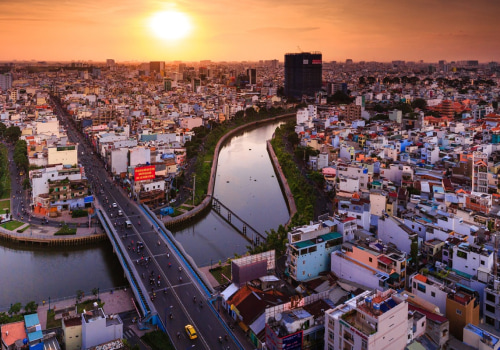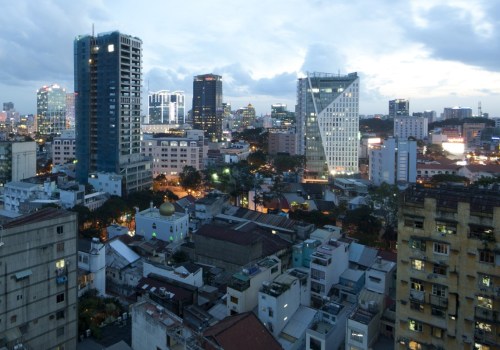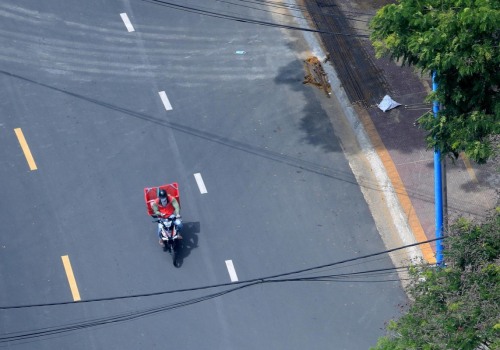Ho Chi Minh City is the city, the largest financial and business center in Vietnam. Also known as Saigon, it has a prominent history dating back hundreds of years. There are many museums showing the country's dark war history and classic colonial architecture built by former French rulers.
Ho Chi Minh
City (also called Saigon) is famous for its pho (traditional Vietnamese noodle soup) and pork rolls.Often the best places are shops and stalls that bear the names of family members, such as Aunty or Chi (meaning sister) followed by a number representing their order in the family and, finally, their name. Although many chains, such as Pho24 and Pho 2000, do big business today, you can't beat family sets because of the real deal. It's been almost 45 years since this city appeared on our television screens every night, but under a different name. Formerly known as Saigon, Ho Chi Minh City was renamed after the late North Vietnamese leader shortly after the end of the Vietnam War, although many people, including Vietnamese, still use the old name.
Fortunately for visitors, most of the main sites of interest are located in a relatively small area (District 1 - Quán) in the city center, making them easily accessible on foot. Here are nine reasons to spend time in Ho Chi Minh City. The palace is located at the southern end of a wide avenue with French-influenced architecture. An earlier palace on the site was home to French administrators, later renamed the Palace of Independence after France left.
It became the home and offices of the presidents of South Vietnam. The current palace was built between 1962 and 1966 to replace the old one that had been severely damaged by Viet Cong shelling. After the end of the war, it was officially renamed the Reunification Palace, but both names are still in common use. A short walk north of the Reunification Palace is the famous Cathedral Basilica of Our Lady of the Immaculate Conception, better known as the Cathedral Basilica of Notre-Dame de Saigon.
Built between 1863 and 1880, when Vietnam was colonized by the French, this cathedral stands out for the iconic statue of Mary on its east side. Right next to the cathedral is another well-known Saigon attraction, the Saigon Central Post Office, built just 6 years after the cathedral. Other area attractions include the Ho Chi Minh City Museum, located in Gia Long Palace, east of Independence Palace. This was the house of the presidents when the Palace of Independence was being rebuilt.
Museum of Ho Chi Minh City (Gia Long Palace) Also in District 1 is the famous Ben Thanh Market, formally established in 1859, but on the site of informal markets dating back another hundred years. The current building dates back to 1912, but it has been restored. Guests at the restaurant Quán Ngon 138 Bespoke itinerary & prompt response within 24 hours. The cathedral is designed in neo-Romanesque style and here you can see the towers, which rise to a height of 40 meters and are topped with impressive iron spires.
The Mekong Delta is made up of 39,000 square kilometers of waterways and is also one of the most densely populated parts of Vietnam. The market was built in the 1880s during the colonial period and here you can take a walk and try the food stalls. The temple dates back to 1902 and is covered with ritual brass ornaments as well as antique weapons. The temple is located near Lake Dam Sen and was founded in the 18th century.
Added to the fascinating cultural upheaval is a number of interesting tourist attractions, from the moving Museum of the Remnants of War and captivating water puppet shows to colourful markets and the time jump of the Reunification Palace. Not far from the city, the famous Cu Chi tunnels are a must-see attraction, and the lush waterscapes and small villages of the Mekong Delta offer a fascinating glimpse into rural life. About 60 kilometers from Ho Chi Minh City, Cu Chi Tunnels are a must-see half-day trip and one of the best tours for visitors to the city. This vast network of tunnels of more than 250 kilometers served as the basis for Viet Cong's military operations during the Vietnam War.
Soldiers used the narrow tunnels as hiding places, hospitals, communication bases, supply routes and even housing. To make the most of your visit, consider joining a full-day VIP tour of the Mekong Delta of the Cu Chi Tunnels & from Ho Chi Minh City. This 11-hour tour includes round-trip transfers by VIP limousine or air-conditioned coach, snacks and cold drinks during the trip, as well as a full Vietnamese lunch (vegetarian option available). You will visit the tunnels of Cu Chi, learn about the welfare of the guerrilla and the booby traps used in the tunnels, and then enter directly into one of the tunnels.
After the tour, you will head to a local restaurant for lunch before continuing to the Mekong Delta. Here, you'll board a small boat to paddle along the coconut-lined canals before heading to a farm to sample local produce, such as honey, tea, and fruits grown there. The War Remnants Museum is one of Vietnam's most popular museums, with harrowing exhibits related to the horrors of war in this war-torn nation. The museum focuses mainly on the Vietnam War, however, some exhibits refer to the first Indochina War with French colonialists.
Vintage weapons and military vehicles are on display in the courtyard of the museum. After touring the countryside and tunnels of Cu Chi, you will find that these exhibits are even more moving, but keep in mind that some of the exhibits are not suitable for young children. Woman paddling along the Mekong Delta Sailing through the lush labyrinth of palm-fringed canals, rivers and islands of the Mekong Delta is a popular day trip that seems to be a world away from the hectic city of Ho Chi Minh City. It offers a fascinating insight into the way of life of people who depend on this fragile waterway for their survival.
With an area of about 40,000 square kilometers, the delta produces more than half of the country's grain and 90 percent of its exports, and is known for its floating markets, which usually take place early in the morning. From Ho Chi Minh City, delta excursions usually involve a 70-kilometer trip to My Tho, a market town on the banks of the Mekong River; a delta cruise and visits to local villages, farms and factories. The Small Group Adventure Tour Discovery of the Mekong Delta offers these activities, as well as the opportunity to sample traditional dishes and tropical fruits from the region. The Golden Dragon Water Puppet Theater is perfect for families with young children and anyone who enjoys casual traditional entertainment.
Water puppets originated in rural villages of the Red River Delta and have been performed in Vietnam for more than 1000 years. The evocative 19th century Thiên Hau Temple is one of the best places to visit in Ho Chi Minh City's Chinatown (ChoLon) and one of the city's oldest Chinese temples. Dedicated to the Lady of the Sea, Thiên Hau, this evocative temple is visited by locals as well as tourists, and many of the materials used in its construction were brought from China. Clouds of incense fly in the air, candles flicker on the altars and rays of sunlight pass through the partial roof as you enter the green wrought-iron doors and stroll through the small courtyard.
From here, you can see the altar, with statues of the goddess and the intricate porcelain dioramas adorning the ceiling depicting scenes of 19th century Chinese life. According to legend, the goddess left two turtles to guard the temple in her absence. On the 23rd of the third lunar month, a parade is held in the neighborhood with the figure of Thiên Hau, who is believed to save seafarers stranded on the high seas. Entrance to the temple is free.
Built from 1877 to around 1883, the cathedral was intended to be a place of worship for colonial missions and a symbol of the power of the French colony. Notable interior features include 56 stained glass paintings by Lorin de Chartres, France; the 12 pillars representing the 12 apostles; and one of the oldest organs in Vietnam. To see inside, try visiting it in the morning or attending a Sunday mass. Across the street, the French colonial-style post office, completed in 1891, was designed by Gustave Eiffel, the French architect of the Eiffel Tower.
Today, the post office is still in use and is a popular gathering place for locals. Also known as the Municipal Theater of Ho Chi Minh City, the elegant Saigon Opera House, at the beginning of the famous tree-lined Le Loi Avenue, is an attraction for architecture lovers, especially fans of French colonial style. It was built as a Saigon Opera House in 1897 by Eugene Ferret, a French architect, to entertain French settlers, and its striking façade echoes the style of the Petit Palais, which was built that same year in Paris. After 1956, the building was used as the seat of the assembly of the lower house of South Vietnam and again became a theater in 1975, after the fall of Saigon.
The only way to see inside the theater is to buy a ticket for a show. A visit to the Reunification Palace, once known as the Palace of Independence, has more to do with the historical events that took place here than with any pomp and grandeur. In fact, this 1960s-style building, with its spacious and spacious rooms and dated furniture, seems frozen in time since April 30, 1975, when a North Vietnamese army tank crashed into the iron gates here, ending the Vietnam War. For the locals, the palace represents this historic event and the reunification of the country.
Set in 44 acres of lush gardens and lawns, the palace also offers a fascinating insight into the lifestyle of privileged heads of state in the 1960s in Saigon. It was built on the site of the former Norodom Palace, which was bombed by warplanes in 1962 in a failed assassination attempt on South Vietnamese President Ngo Dinh Diem. The current building was completed in 1966 and became the home and workplace of the successive president when Vietnam was divided between north and south. Notable features include the president's dwellings, the war command room with large maps and outdated communications equipment, and the basement's maze of tunnels.
You'll also see military vehicles outside, including the fighter plane that destroyed Norodom Palace and the 843 tank, which broke through the palace gate that fateful April day, more than four decades ago. Guided tours are offered in English. Almost as interesting as the museum's exhibits is the building itself, which dates back to 1929 and merges French and Asian architectural styles. After viewing all of the museum's exhibits for about an hour, you can enjoy a relaxing stroll through the botanical gardens.
Built in the early 20th century, the evocative Jade Emperor Pagoda (Chua Phuoc Hai) is located in a simple neighborhood a few blocks from the Botanical Garden. The temple was built in honor of the Taoist god, the Jade Emperor or King of Heaven, Ngoc Hoang, and inside its dimly lit interior, you will see many depictions of Buddhist and Taoist deities. While the northern half of Vietnam experiences a cold season between December and March, the southern half of the country experiences average temperatures of 30 degrees Celsius throughout the year. However, these are still the best months to visit Ho Chi Minh, as there is little rain, lots of blue skies and the humidity drops enough to make the weather more bearable.
December can even give you a few days here and there when the temperature drops below 30 degrees Celsius. On the other hand, April is the hottest month, with temperatures above 30°C and high humidity. The ghosts of the past live in buildings that a generation ago witnessed a city in crisis, but now the true beauty of Saigon's ancient urban collage is the perfect combination of these two worlds in an exciting mass. A visit to Saigon is like an encounter with exotic and delicious food, French colonial architecture and memories of the Vietnam War.
From the best hotels to the cheapest guesthouses, the most elegant restaurants to the tastiest street stalls, the finest boutiques and the scrum of markets, HCMC is a city of energy and discovery. A few hours from Ho Chi Minh City, you can find the Mekong Delta mekong meandering through the lush countryside. The museum exhibits thousands of items related to traditional Vietnamese medicine, from the Stone Age to the present day, including books, documents, herbs and implements used in the preparation of medicines. According to the sign at the entrance, the kitchen was furnished with what was the most luxurious of modern equipment, of a standard for a five-star hotel.
You can feel that Ho Chi Minh City is overwhelmingly busy, as it is the largest city in the country and a thriving center of commerce. This means that it is not possible to enter the church; however, it is worth visiting from the outside. Ben Thanh Market is located in the center of Ho Chi Minh City and is a great place for shopping and dining. From cheap meals to tasty vegetarian options and Vietnamese fusion, these are the best places to eat in Ho Chi Minh City.
Many argue that the museum's approach is biased; however, the exhibits poignantly depict the brutality of the war. . .




